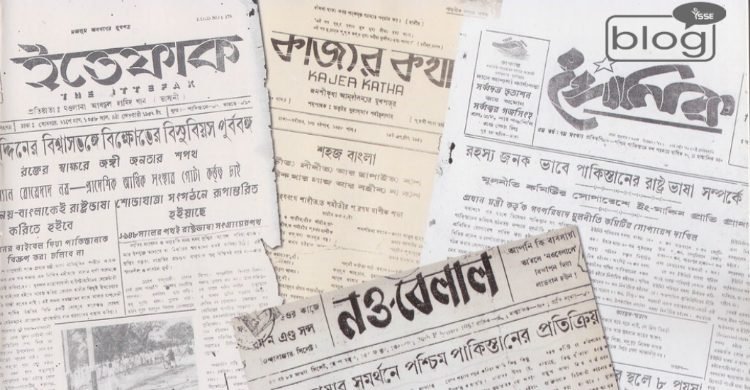The Bengali people had to go through a rigorous struggle in order to make Bangla the official language of Bangladesh or the then East Pakistan.
The strive for establishing Bengali as official language of East Pakistan gained momentum in 1952 through the language movement.
In 1952, the then prime minister Khawaja Najimuddin wanted to establish Urdu as the state language which provoked the students and leaders of different parties, leading to the general strike on 21st February.
Anyone who looks into the newspapers that were published on a given day will undoubtedly gain an empirical understanding of what was going on at that precise moment.
It might be argued that newspapers played a major role in the development of our wonderful linguistic revolution.
Newspapers were the most dependable source for information about the movement’s overall success back then for the general public.
Additionally, language movement advocates had little other options than newspapers to inform the general public about their goals.
In those turbulent days,the pro-government newspaper Morning News published fake news and editorials condemning the movement.
The students were enraged by the newspaper’s attitude and chased their vehicles whenever they saw them on the streets.
After the killings in Dhaka, the government claimed that the movement was aimed at secession from Pakistan by the communists and described them as subversive and highly ambitious, and some disaffected local politicians and Indian agents.
The morning news also circulated about the canard that Indian Hindus gathered in a medical hostel on 21 February.
The daily Sangbad was also uncritical of the Muslim League government at the time.
According to Language Movement veteran Ahmed Rafiq, it resorted to lies and acts that violated journalistic rules and norms, although some progressive journalists once worked there.
Enraged by the newspaper’s controversial stance, protesters have chased and attempted parade attacks on its vehicles and reporters since 22 February.
Meanwhile, the newspapers and weeklies that pressured the government through reports and editorials were Daily Azad and Daily Insaf and three weeklies — Sainik, Ittefaq and Sylhet’s Naubelal.
The Daily Azad tried to take advantage of the public atmosphere; launched an evening Telegram edition targeting the movement that surprised many protesters, Ahmed Rafiq said. Since February 21, newspapers have published many reports about the movement and published the names of the dead and injured.
On February 22, an editorial questioned whether it was necessary to apply Section 144 and open fire on the demonstrators, while also calling for a probe into the police shooting. It also questioned the authorities on the wisdom of aiming at the upper torso.
Political journalist ZA Suleri, editor of the Karachi-based Evening Times, visited Dhaka to learn firsthand the events of February 21-22 because of the rumors spread by the government and Morning News newspaper.
“The demand for establishing Bangla as a state language has full public support. Patriotism is the main source of this demand,” Suleri said in a statement.
The Evening Times and Evening Star, another Karachi-based newspaper, demanded an investigation into the deaths of protesters and expressed condolences to the families of the martyrs.
The February 23 editorial of Dawn supported the cause behind the movement, saying that the deaths could have been averted had the police refrained from opening fire.
“A vast section of the student community has demonstrated being inspired by their heartiest belief… Through these events, we have noticed how deeply our relatives in East Pakistan feel about the language-related problem,” it read.
To read more blogs like this, click here.
Writer
K M Jahin
Intern, Content Writing Department
YSSE

